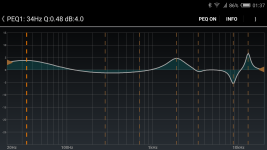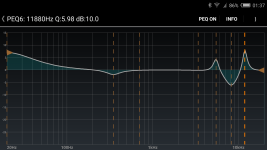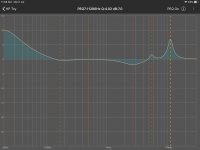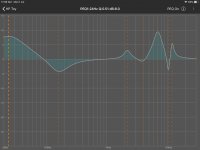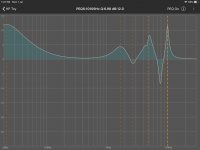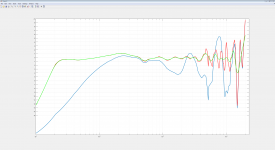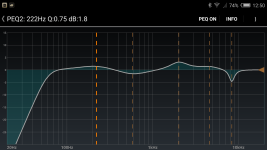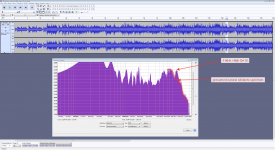I using two sources of curves Home Page | InnerFidelity and Reviews and Ratings - RTINGS.com Innerfidelity's HE400i curve was compensated by the Harman curve because of their data is "Head Acoustics HMSII". Rtings curves already compensated with the Harman's curve. Interesting, that results are quite similar in highs, i.e. reduce 8kHz and increase 12kHz. The most noticeable difference in 2kHz(Innerfidelity) vs 5.5kHz(rt) boost and also the rt's sub-bass boost is higher. Subjectively, Innerfidelity version of the Harman's curve is more pleasant, and 100% clear why +5db at 5.5kHz makes voices scream  But anyway, I surprised that results are close enough, it seems that measurements aren't useless.
But anyway, I surprised that results are close enough, it seems that measurements aren't useless.
Attachments
Headphone measurements are not easy and are mostly quite useless if not done well on good equipment.
It is not really useful to use two curves from two different rigs(since different rigs produce different results) to do a compensation transform of XY measurement/s. It has to be compatible with the target curve from that system.
This one is done on GRAS43A coupler with anthropometric pinna:
Dropbox - Hifiman HE400i (preliminary).pdf - Simplify your life
It has EQ settings for 400i to fit Harman Target.
Best regards.
It is not really useful to use two curves from two different rigs(since different rigs produce different results) to do a compensation transform of XY measurement/s. It has to be compatible with the target curve from that system.
This one is done on GRAS43A coupler with anthropometric pinna:
Dropbox - Hifiman HE400i (preliminary).pdf - Simplify your life
It has EQ settings for 400i to fit Harman Target.
Best regards.
However, for the HD600 I found a huge difference and no idea which one measurement is closer to reality(I have no HD600, if somebody has it and wish to try to equalize, please let me know)..
Attachments
bozic, thank you for the referral pdf file, I tried to make Harman target compensation for that. First, the equalization they made doing almost nothing in region 80-5000Hz which initially had +/-3db, and after compensation +/-1db, it is difficult to notice the difference. Second, I made more accurate, complete compensation which includes 8kHz peak, 5kHz, and 10kHz dips, see attached. I have to say, that complete compensation sounds awful, and I understand why EQs in pdf leaves those dips/peaks uncompensated. I don't know where is the mismatch, my HE400i could be too much different vs measured in your pdf or some mistake of the measurement but accurate equalized plot from your pdf sounds obviously wrong with my HE400i. If you have some measurements else, please let us see. I like to compare with innerfidelity's and rt's data.
PS: I've attached one more screenshot from Matlab, the blue plot is from your pdf, red one after my 7 parametric EQs applied, green the same like red but smoothed.
PS: I've attached one more screenshot from Matlab, the blue plot is from your pdf, red one after my 7 parametric EQs applied, green the same like red but smoothed.
Attachments
Oh, I found that reddit: the front page of the internet
Interesting that HD600 response similar rather to rt data than innerfidelity data )) Chaos, pretty much chaos and everyone who decided to use EQ has to have ears to avoid worse sound after equalization.
PS: I gonna try to A/B compare HE400i and my DIY speakers, which have calibrated frequency response (+/-2db within 80-10000 Hz at least) in my uncalibrated living room
Interesting that HD600 response similar rather to rt data than innerfidelity data )) Chaos, pretty much chaos and everyone who decided to use EQ has to have ears to avoid worse sound after equalization.
PS: I gonna try to A/B compare HE400i and my DIY speakers, which have calibrated frequency response (+/-2db within 80-10000 Hz at least) in my uncalibrated living room
bozic, innerfidelity uses B&K Artificial Ear system $25000, if we're not gonna trust such instruments what we should do?
I am pretty sure they sold it to Dekoni, a company that makes replacement earpads. After Tyll retied innerfidelity does not make headphone measurements anymore.
Trying to do compensation transform from measurements can be quite and/or straight up impossible/sensless. Headphone X measured on different rigs can produce very different results and this difference is not the same for every headphone
If you make compensation from the pdf, make sure to adjust all the eq stetting right(filter type, gain, Q-factor).I tried to make Harman target compensation for that. First, the equalization they made doing almost nothing in region 80-5000Hz which initially had +/-3db, and after compensation +/-1db, it is difficult to notice the difference. Second, I made more accurate, complete compensation which includes 8kHz peak, 5kHz, and 10kHz dips, see attached. I have to say, that complete compensation sounds awful, and I understand why EQs in pdf leaves those dips/peaks uncompensated. I don't know where is the mismatch, my HE400i could be too much different vs measured in your pdf or some mistake of the measurement but accurate equalized plot from your pdf sounds obviously wrong with my HE400i.
There might be several reasons(and combination of those) why you dislike the compensation:
1. You do not like the proposed Harman Target cruve. In fact many do not! And the research done by Mr. Olive has some methodological issues.
2. There is some variation in between same model of headphones, that variation can be VERY audible and HIFIMAN is not knows for their quality control.
Fortunately I did not spend so much money on a expensive measurement rig for headphonesIf you have some measurements else, please let us see. I like to compare with innerfidelity's and rt's data.
I did use a simple DIY plate coupler(with UMIK2 mic I think) when I moded my T50RP, it was useful to tracking the effects of physical mods and channel balancing.
All that being said, I do use the oratoy1990's preset(very slightly modded, one db up and down on different frequencies in bass region) with my HD650 and I am very pleased. I think the mentioned reddit user even does custom measurements(if you send him your headphones that is) and that would be the best option IMO.
Best regards.
It is not a Harman curve at all, the result is 100% wrong and sound awful. Seems you didn't catch what I said. My compensation is more accurate vs oratory1990 which didn't try to compensate peak/dips from 5kHz and higher. I didn't try original oratory1990 compensation for this reason. I could make the conclusion: the data published in the pdf is wrong, even the author itself didn't trust his data from 5kHz and higher. About HE400i you are right, does exist many quite different models HFM headphones with the same model name. Some of them even have reversal magnet/membrane construction and still named "HE400i", but it doesn't explain why oratory1990 didn't compensate over 5kHz, right?1. You do not like the proposed Harman Target cruve. In fact many do not! And the research done by Mr. Olive has some methodological issues.
I think many guys who reed that topic want to ask - If different equipment, and a quite expensive one(Artifical Ear $25000 and it is the cost of APx555 audio analyzer, and no one have questions for its performance), makes so much different result, what's a practical reason to pay such money for a mirage? What is the technical reason for such unpredictable measurement result? The particular shape of the artificial ear?
I've finished my experiment about HFM HE400i equalizing into the perceptually captured response of my speakers in the living room. Instruments:
1) DIY speakers 92db*w/m (no echo chamber freq.resp. 50-10kHz +/-2db, and up to 20kHz with some dip/peaks +/-3..5db)
2) Amp like this HiFiTOY | index
3) HE400i 2017 no mods
4) true digital headphone interface >300mW/ch with DSP controlled by iPad/Android
4) Ears(big, with less than 20Hz and over 21kHz limits), brain(always hungry)
5) tracks:
Marantz Hi-End Audiophile Test Demo SACD (7th Edtion)
Semyon Bychkov - Tchaikovsky_Manfred Symphony (2017) [24-96]
VA-Greatest_Audiophile_Voices_I-2011
Calum Scott - Only Human (Deluxe) (2018)
Diana Krall - 2017 - Turn Up The Quiet
Linn - 2008 - Gourmet Jazz
Yundi Li Chopin Nocturnes 2010
pink-noise
I started from the volume matching and understand that's even this one essential procedure isn't trivial. Perception of the speaker volume, as I noticed, includes vibrations sense of a body. So better to match volumes speaker vs headphone with 1kHz tone(or noise after HPF 300-500Hz) instead of music. I have cut headphone response with HPF 50Hz due to 8" speakers don't have SPL lower 45-50Hz.
Very first frequency what I hear as mismatched is 2kHz, HE400i obviously need +3..5db up EQ here, that makes vocals more opened. The second frequency is 8kHz, and I think -4db Q=5 is fine. Third one it is around 100-300Hz(200Hz Q=.5) region which needs to lift up for +3-7db and.. very much depends on music content. I was wondered why that correction is so content depended and tried to use pink-noise instead of music. Here was a big surprise, the pink-noise correction was just about +2db or so at 200Hz. I'm sure this phenomenon based on the fact that human's brain has built-in compressor(a few mS attack and 50mS release), and I heard amplified room's echo as a 200Hz boost, which almost disappeared at the continuous aperiodic signal(pink-noise). In fact, I think 200Hz correction is no need at all because it makes boomy basses and reduces articulation. 600Hz -2db is also something related to room echo-reflections and that needs only to reduce boomy men's voices if 200Hz got a +5-7db boost. 4-5kHz +1.5-2db probably doesn't need as well, because of my speakers freq.response has comparable tolerance. About 10-20kHz region, I didn't notice any needs to correct there anything, however, I found only one track which has a hi-hat and sibilances sounding very differently on speakers. The track is 26-tipitina_-_dream_a_little_dream_of_me from VA-Greatest_Audiophile_Voices_I-2011 I feel there is some high Q EQ around 15kHz +5-8db applied during the mastering. One more interesting detail of that experiment, I suddenly found 100% precise way to get the exact frequency of "8kHz" peak, I simply slide my finger on the Android's screen left-right-left during pink-noise plays, and I very clearly heard the particular frequency where the whistle-like tone is gone. In other words, if you can control your EQ on the fly(online), with no delay to click or select something, you can correct a hight-Q resonants just by your hearing. A brain does an adaptation for any kind of environment noise quite fast, that's why any GUI delay makes manual equalization less efficient.
Finally, I think that only 2 EQ bands are important for my headphone 2.022kHz +3.2db Q=1.54 and 8.379kHz -5db Q=5.52, really minor corrections are 4.614kHz +1.1db Q=1.44, 582Hz -2db Q=.89, 153Hz +2db Q=.75.
Let's compare that result vs other Harman like equalizations what I have:
1) innerfidelity data based, 1.899kHz +5db Q=1.51 that's close to my experimental result. 8.712Hz -6db Q=5.09 also the same as experimental result. 13kHz +7db Q=6 this one I think is no need at all, and that EQ makes noticeable brighter highs vs speakers. Probably the plot what I captured from innerfidelity was smoothed and the Q factor was distorted by this fact. Others EQs are less than 2db and doing pretty much nothing. Verdict: practically approved preset for my HE400i, only need to increase Q-factor for 13kHz boost or reduce the boost value.
2) Reviews and Ratings data based, no any EQ at 2kHz at all, but have one at 5.5kHz +6db Q=5 that sounds screamy and I don't believe if someone may like it. 8.2kHz -7 Q=2 and 11.8kHz +10db Q=6 it is looking weird but the sound in highs is quite close to innerfidelity data based preset yet, and brighter than speakers again. 350Hz -2db Q=2. Verdict: it is close to innerfidelity data based preset but screaming at 5.5kHz.
3) oratory1990 data based accurately compensated up to 10kHz, 1.7kHz +4.5db Q=1.4 close to experimental result again, 2.7kHz -4db Q=3 it is something new what not presented in all previous presets. pair 4.7kHz -6db Q7 and 4.9kHz +13db Q=3 nicely covered the complex shaped dip but produces venomously screaming sound. 7.7kHz -11db Q=6 and 10.1kHz +13db Q=7 make crazy over-boosted treble. Verdict: forget about it, probably it is about another headphone at all. HFM likes to name different stuff equally.
Conclusions:
1) Chaos is confirmed.
2) Don't believe any curves about your headphone's frequency responses over 10kHz.
3) Every one dude with a decent speaker system able to compare his headphones A/B manner, and 50% of them able to adjust EQlization if they wish, 10% successfully(some headphones, such as LCD2 has a huge dip in 2kHz, probable compensation will be around +10..15db!).
4) Every one dude, If he sold out wife's car, may purchase Artificial Ear and try to make a compensation seriously. Anyway, the device is not as big and finally will get the place in the half-empty garage))
1) DIY speakers 92db*w/m (no echo chamber freq.resp. 50-10kHz +/-2db, and up to 20kHz with some dip/peaks +/-3..5db)
2) Amp like this HiFiTOY | index
3) HE400i 2017 no mods
4) true digital headphone interface >300mW/ch with DSP controlled by iPad/Android
4) Ears(big, with less than 20Hz and over 21kHz limits), brain(always hungry)
5) tracks:
Marantz Hi-End Audiophile Test Demo SACD (7th Edtion)
Semyon Bychkov - Tchaikovsky_Manfred Symphony (2017) [24-96]
VA-Greatest_Audiophile_Voices_I-2011
Calum Scott - Only Human (Deluxe) (2018)
Diana Krall - 2017 - Turn Up The Quiet
Linn - 2008 - Gourmet Jazz
Yundi Li Chopin Nocturnes 2010
pink-noise
I started from the volume matching and understand that's even this one essential procedure isn't trivial. Perception of the speaker volume, as I noticed, includes vibrations sense of a body. So better to match volumes speaker vs headphone with 1kHz tone(or noise after HPF 300-500Hz) instead of music. I have cut headphone response with HPF 50Hz due to 8" speakers don't have SPL lower 45-50Hz.
Very first frequency what I hear as mismatched is 2kHz, HE400i obviously need +3..5db up EQ here, that makes vocals more opened. The second frequency is 8kHz, and I think -4db Q=5 is fine. Third one it is around 100-300Hz(200Hz Q=.5) region which needs to lift up for +3-7db and.. very much depends on music content. I was wondered why that correction is so content depended and tried to use pink-noise instead of music. Here was a big surprise, the pink-noise correction was just about +2db or so at 200Hz. I'm sure this phenomenon based on the fact that human's brain has built-in compressor(a few mS attack and 50mS release), and I heard amplified room's echo as a 200Hz boost, which almost disappeared at the continuous aperiodic signal(pink-noise). In fact, I think 200Hz correction is no need at all because it makes boomy basses and reduces articulation. 600Hz -2db is also something related to room echo-reflections and that needs only to reduce boomy men's voices if 200Hz got a +5-7db boost. 4-5kHz +1.5-2db probably doesn't need as well, because of my speakers freq.response has comparable tolerance. About 10-20kHz region, I didn't notice any needs to correct there anything, however, I found only one track which has a hi-hat and sibilances sounding very differently on speakers. The track is 26-tipitina_-_dream_a_little_dream_of_me from VA-Greatest_Audiophile_Voices_I-2011 I feel there is some high Q EQ around 15kHz +5-8db applied during the mastering. One more interesting detail of that experiment, I suddenly found 100% precise way to get the exact frequency of "8kHz" peak, I simply slide my finger on the Android's screen left-right-left during pink-noise plays, and I very clearly heard the particular frequency where the whistle-like tone is gone. In other words, if you can control your EQ on the fly(online), with no delay to click or select something, you can correct a hight-Q resonants just by your hearing. A brain does an adaptation for any kind of environment noise quite fast, that's why any GUI delay makes manual equalization less efficient.
Finally, I think that only 2 EQ bands are important for my headphone 2.022kHz +3.2db Q=1.54 and 8.379kHz -5db Q=5.52, really minor corrections are 4.614kHz +1.1db Q=1.44, 582Hz -2db Q=.89, 153Hz +2db Q=.75.
Let's compare that result vs other Harman like equalizations what I have:
1) innerfidelity data based, 1.899kHz +5db Q=1.51 that's close to my experimental result. 8.712Hz -6db Q=5.09 also the same as experimental result. 13kHz +7db Q=6 this one I think is no need at all, and that EQ makes noticeable brighter highs vs speakers. Probably the plot what I captured from innerfidelity was smoothed and the Q factor was distorted by this fact. Others EQs are less than 2db and doing pretty much nothing. Verdict: practically approved preset for my HE400i, only need to increase Q-factor for 13kHz boost or reduce the boost value.
2) Reviews and Ratings data based, no any EQ at 2kHz at all, but have one at 5.5kHz +6db Q=5 that sounds screamy and I don't believe if someone may like it. 8.2kHz -7 Q=2 and 11.8kHz +10db Q=6 it is looking weird but the sound in highs is quite close to innerfidelity data based preset yet, and brighter than speakers again. 350Hz -2db Q=2. Verdict: it is close to innerfidelity data based preset but screaming at 5.5kHz.
3) oratory1990 data based accurately compensated up to 10kHz, 1.7kHz +4.5db Q=1.4 close to experimental result again, 2.7kHz -4db Q=3 it is something new what not presented in all previous presets. pair 4.7kHz -6db Q7 and 4.9kHz +13db Q=3 nicely covered the complex shaped dip but produces venomously screaming sound. 7.7kHz -11db Q=6 and 10.1kHz +13db Q=7 make crazy over-boosted treble. Verdict: forget about it, probably it is about another headphone at all. HFM likes to name different stuff equally.
Conclusions:
1) Chaos is confirmed.
2) Don't believe any curves about your headphone's frequency responses over 10kHz.
3) Every one dude with a decent speaker system able to compare his headphones A/B manner, and 50% of them able to adjust EQlization if they wish, 10% successfully(some headphones, such as LCD2 has a huge dip in 2kHz, probable compensation will be around +10..15db!).
4) Every one dude, If he sold out wife's car, may purchase Artificial Ear and try to make a compensation seriously. Anyway, the device is not as big and finally will get the place in the half-empty garage))
Attachments
I've checked the track which sounds noticeably different with experimental EQ-preset HE400i vs speakers, and I found 11kHz peak looks like +9db Q=10 EQ. My speakers played that song with obvious over-boosted sibilants but headphone was kind of deaf for that fact, hence, the preset need to be refined for 11kHz hight Q boost. And listen to music again 
Attachments
Well, and how it does sound practically? Captured with the single WM61A on a flat panel(no artificial ear), next time-dealy aligned(imperfectly).
YouTube
BTW, HE400i frequency response seriously depends on pads pressure. When I used 2 tight rubber rings to fix the mic's panel on the headphone, I got bass 0db at 20Hz and no any peak at 8kHz at all! If I used normal pressure, as my head feels, then 20Hz drops 7db, 8kHz + 4-7db depend on pressure.
YouTube
BTW, HE400i frequency response seriously depends on pads pressure. When I used 2 tight rubber rings to fix the mic's panel on the headphone, I got bass 0db at 20Hz and no any peak at 8kHz at all! If I used normal pressure, as my head feels, then 20Hz drops 7db, 8kHz + 4-7db depend on pressure.
Last night I found that innerfifelity changed the compensation curve in 2017 i.e. before 2017 their measurements were different vs after 2017, and they didn't correct old data. What can I say about that? It seems our planet is the origin of global chaos. And nobody care, right? IMO that way civilizations dying.
PS: the only way to get more or less correct data from innerfidelity is to recover the raw data directly from a mudy-gray plot. It is crazy stupid but the only way.. Interesting that the author of that bloody mess was kinda semi-god vs rest reviewers ))
PS: the only way to get more or less correct data from innerfidelity is to recover the raw data directly from a mudy-gray plot. It is crazy stupid but the only way.. Interesting that the author of that bloody mess was kinda semi-god vs rest reviewers ))
Last edited:
I use the frequency Curves at rtings and inner fidelity as rough guidelines, then eq to my own taste.
Everyone's head is a bit different, so every headphone will sound a bit different for everyone.
YouTube
Interesting read: Audio Musings by Sean Olive: TWiRT 337 – Predicting Headphone Sound Quality with Sean Olive
QUOTE from article: The highest scoring headphone was a $100 model that we equalized to hit the Harman target response, which our research has shown to be preferred by the majority of listeners.
There are in ear microphones, so you can measure how your headphone reasonce, but I can't find them right now.
Everyone's head is a bit different, so every headphone will sound a bit different for everyone.
YouTube
Interesting read: Audio Musings by Sean Olive: TWiRT 337 – Predicting Headphone Sound Quality with Sean Olive
QUOTE from article: The highest scoring headphone was a $100 model that we equalized to hit the Harman target response, which our research has shown to be preferred by the majority of listeners.
There are in ear microphones, so you can measure how your headphone reasonce, but I can't find them right now.
Bill, I'm sure the equalizing to user own taste is the shortest way to the nirvana. Especially if that user is a trained listener. BTW, I suddenly got level 9 with Olive's how_to_listen app, it is close to level 12 of Harman's trained volunteers, which helped to found the Harman curve. So I feel I can easily adjust any headphones to match vs linear speakers or any particular speakers/headphones whatever. But how it can help normal listeners with level 3? Before yesterday I did believe I can finish Matlab script able to build IIR filters to transform any plot from innerfidelity into the Harman curve. Last night I found info about 2017 they changed the compensation curve. So now I think will be a good idea if I'll switch my attempts to RTINGS data, I'll try to find a correlation vs my ears equalization result with my HE400i and next, I'll prepare EQ prest for other HP(LCD2 or LCD2C etc what I have a plan to buy) and check the sound. The best way if someone has a lot of decent HPs and has high enough Harman's how_to_listen app skils level to evaluate EQ preset but if nobody else interested in that stupid topic, I need to buy dozen HPs and get my way to nirvana 
Haha, I've got an interesting and cost-effective idea how to help users to compensate given frequency response on the iPhone/Android screen. I'll let users add frequency response plot to the parametric EQ GUI as background bitmap flipped vertically. So the process of compensation will be simple as never before ))
- Status
- This old topic is closed. If you want to reopen this topic, contact a moderator using the "Report Post" button.
- Home
- Amplifiers
- Headphone Systems
- Equalization according to measurement, experience.
